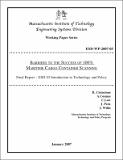| dc.contributor.author | Cirincione, R. | |
| dc.contributor.author | Cosmas, A. | |
| dc.contributor.author | Low, C. | |
| dc.contributor.author | Peck, J. | |
| dc.contributor.author | Wilds, J. | |
| dc.date.accessioned | 2016-06-03T00:16:13Z | |
| dc.date.available | 2016-06-03T00:16:13Z | |
| dc.date.issued | 2007-01 | |
| dc.identifier.uri | http://hdl.handle.net/1721.1/102882 | |
| dc.description.abstract | The attacks of September 11, 2001 revealed national security vulnerabilities that had previously not received high level priority in the United States, such as insecure transportation and infrastructure networks. In response, airport security—including passenger and baggage scanning—has been improved. Yet seaport security policies have been slow to change. Five years after 9/11, only 5% of the six million cargo containers that arrive at U.S. seaports are scanned for threats. | en_US |
| dc.language.iso | en_US | en_US |
| dc.publisher | Massachusetts Institute of Technology. Engineering Systems Division | en_US |
| dc.relation.ispartofseries | ESD Working Papers;ESD-WP-2007-05 | |
| dc.title | Barriers to the Success of 100% Maritime Cargo Container Scanning | en_US |
| dc.type | Working Paper | en_US |
